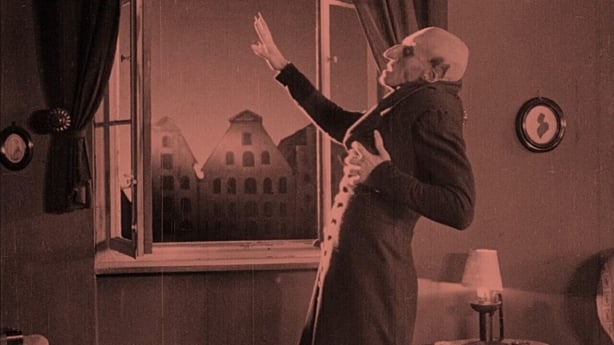For this year's Bram Stoker Festival, composer Matthew Nolan presents his new score for the original vampire movie, Nosferatu, accompanying a special screening of the film at Dublin's Pepper Canister Church.
The first on-screen adaptation of Dracula, one hundred years later Nosferatu continues to haunt — and, indeed, terrify — modern audiences with the unshakable power of its images.
Below, Nolan explores the challenges of re-imagining the music for a silent film classic...
Creating a contemporary score for older cinema is creating a vibrant and dynamic dialogue between artists across decades, or in the case of Nosferatu, a whole century. The intervention of a new musical score can opens up the possibility of a new mode of appreciation. Today we are at the beginning of a compelling new art form, contemporary scores for not just silent cinema but films with pre-existing and often iconic music. In some respects, it brings film back to its early days as a site of spectacle. It allows a film to have multiple scores, perpetuating a creative dialogue with our cinematic past, allowing new audiences to rediscover them, and to keep them relevant.
It doesn't replace the original score, nor does it draw a line between these scores and more contemporary, even unorthodox ones. But the contemporary score for an older film, both recorded, and at its best, in live performance is a distinct art form, often independent of the previous conceptions of the relationship between film and music at the time of production. This new approach offers rich opportunities on multiple levels for experimentation in film music. It also represents an ongoing examination and affirmation that the art form of contemporary scores for older cinema represents a rich opportunity for an innovative and alternative audience experiences.

A huge amount of into creating an appropriate and artistically respectful accompaniment for a silent film. An effective and psychologically motivated score requires patience, a keen understanding of the basic language of cinema, and a constant requirement to place the needs of the film above your own creative desires. The music "must" always be in service to the film. So, phase one of drafting a film score involves very little by way of composition or even experimentation with music or sound. That initial time with the work is spent watching, re-watching, and aligning yourself with every visual and psychological nuance. Taking time to live in the film before committing to music helps maintain respect for the director's work. It is important to know your place!
Unfortunately there are no strict rules which govern how you approach the creation of a score. However in my experience I have found establishing a series of voices and textures affords me a provisional structure to start thinking musically within. This sonic architecture becomes the means through which you find an alternative set of gestures to support the work of the film itself. At this stage of the creative process, it is really important not to lose sight of what the film needs. There have been times where pieces of music that I am really proud of end up getting binned because they are not working well to picture. You start to understand intuitively if something is not working straight away but sometimes your own ego prevents you from making a hard decision. It’s for this reason I find myself drawn to projects which open up a collaborative space. Finding likeminded people with the same regard for cinema and visual culture is crucial here.
It’s for these reasons that musicians Jeff Ballard, Sean Mac Erlaine, and Sharon Phelan have been invited into the fold to collaborate on a new score for this horror classic and indeed the first cinematic rendering of Stoker’s novel. These guys understand the process on a formal and intuitive level. It sets up a creative journey that is always full of surprises, for musicians and audience alike.
Nosferatu100 is at the Pepper Canister Church, Dublin, on Saturday 29 October at 6.30pm and 9pm - find out more here, and explore this year's Bram Stoker Festival programme here.

